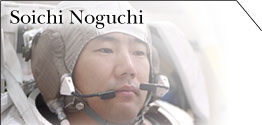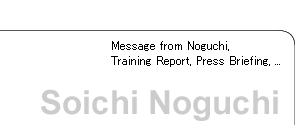Astronaut Noguchi's Training Report, #3
Daily training courses usually in JSC, occasionally in sky.
Last Updated: June 24, 2002
Astronauts are being trained for the launch in various ways everyday based mainly in Johnson Space Center, Houston.
Several training cases are reports here.
Training using the motion base
We spend the largest portion of time in STS-114 mission-specific training using a simulator called the motion base, which simulates the space shuttle flight deck and has hydraulic drives to simulate flight motion. Many other kinds of simulators are used, depending on the mission and crewmembers participating in the training. For example, we use a specific simulator for training in robot arm operation or space shuttle docking with the International Space Station (ISS). We use a simple simulator or one that does not move but accurately simulates monitor displays for training with a few crewmembers. We use different simulators depending on the situation.
 |
 |
We have used the motion base since our basic training and have conducted training using it with the same members many times since the crew training began. Recently, we have been conducting training for dynamic states of Space Shuttle flight such as launch or reentry. We should complete many tasks in a short period of time, especially for launch or reentry, so we need to learn how to cooperate and each member's tasks and responsibilities through simulations.
Additionally, I try to make sure that I can get data on the display and report to other members, catch words from the ground and open related pages of manuals to perform required operations under erratic movement and vibration conditions.
The other day, I received training on wearing an orange Launch and Entry Suit (LES) that I will wear for actual launch and landing. I could not move well with the pressurized LES, and gloves made operations difficult. In my seat behind the Pilot, I could not see the front panel well because of his expanding suit. In spite of this, I had to check other panels and condition of systems. I realized the difficult points of working in the LES through this training.
T-38 flight training
Occasionally, I receive flight training using a T-38 jet plane. I fly with Pilot Jim Kelly and learn crew coordination and T-38 systems to develop the ability to control and operate spacecraft systems.
In the T-38, I sit behind the Pilot, and we cooperate in flying the aircraft. If a problem occurs, I confirm the check list and the Pilot executes it. On long flights, we operate the aircraft in rotation.
For the STS-114 mission, I will sit behind the Pilot and help him. Therefore, I try to develop crew coordination between the two of us as well as my skill as a pilot through this training.
Emergency escape training and Survival training at NBL
Astronauts are trained so that they can return safely even in in-flight emergencie. In case of an emergency during launch or reentry, the first objective is to descend and return to Earth. If all three engines stop during launch or if directions are lost due to a major navigation instrument malfunction, we have to control the Shuttle's attitude so that we can safely escape from the Shuttle, and then jump out of the Shuttle one after another.
Once launched, Space Shuttle flies toward the Atlantic Ocean. Assuming an emergency sea landing, we use a huge water pool called the NBL and are trained to escape through a hatch and survive on the ocean till rescue arrives.
The LES, which we wear during launch and reentry, and the parachute bags, contain a raft, a medical kit, a float, potable water, and a radio. After reaching the water, we trained on how to remove the parachute and climb into an inflated raft.
The NBL facility simulates microgravity conditions of space. Full-dress EVA training will be started at the end of May. This training will be reported at another time.





